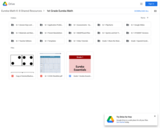
concepts found in Eureka Math- 1st grade
- Subject:
- Mathematics
- Material Type:
- Activity/Lab
- Author:
- Liberty Public Schools
- Missouri
- Date Added:
- 04/06/2021

concepts found in Eureka Math- 1st grade

Overview: In this lesson, students will particpate in three separate learning activities. These activities are each made to help improve the students' knowledge of creating real-world problems to represent an addition and a subraction equation within 20. At the end of the lesson, there is an assessment in order to check the effectivenss of the learning activities

This lesson will help students understand how a shadow is created and allow them to experiment with creating shadows.

This is complete workout for the first day of practice at Modesto Junior College.It gives the sets and the total yards for the workout.
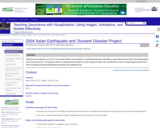
This is a problem-based learning (PBL) group jigsaw activity. The scenario is:
Students are employees of a unit of the United Nations responsible for coordinating disaster relief after a major disaster (the 2004 Asian Earthquake and Tsunami) occurs. The agency needs to understand the situation in each country so that it can coordinate the work of various governments and nongovernmental organizations (NGOs) working in the affected area.
Students are divided into Expert Groups (related to academic specialties such as Economics, Medicine, Political Science, Earth Science, etc.) and spend several days researching their topics. Students are then reassigned to one of seven or eight Country Groups, based on the countries most affected by the disaster. Each country group needs someone representing each expert group. In the scenario, these groups correspond to task forces that must determine what the situation is in each country and try to assess the current need for international assistance.
Students research their country, using internet resources, especially the CIA World Factbook and ReliefWeb, the information coordination website of the United Nations. At a large-group roundtable discussion, each group presents what it has found about its assigned country. As a final product, each student writes an individual report summarizing findings and making recommendations for disaster assistance.
(Note: this resource was added to OER Commons as part of a batch upload of over 2,200 records. If you notice an issue with the quality of the metadata, please let us know by using the 'report' button and we will flag it for consideration.)
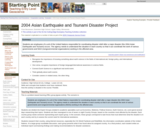
Students are employees of a unit of the United Nations responsible for coordinating disaster relief after a major disaster (the 2004 Asian Earthquake and Tsunami) occurs. The agency needs to understand the situation in each country so that it can coordinate the work of various governments and NGO (nongovernmental organizations) working in the affected area.
(Note: this resource was added to OER Commons as part of a batch upload of over 2,200 records. If you notice an issue with the quality of the metadata, please let us know by using the 'report' button and we will flag it for consideration.)
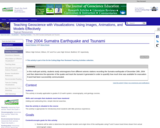
In this multi-part activity, students study seismograms from 3 different seismic stations recording the magnitude 9.0 Sumatra earthquake of December 26th, 2004. By comparing the arrival times of the P and S waves on each seismogram, students determine the distance from the epicenter to each station. Using that data, they can accurately map the location of the epicenter and the precise time of the earthquake. After locating the epicenter, students calculate the position of the tsunami generated by the quake at one hour intervals. From those determinations, predictions are made about how much time people had before the tsunami crashed onto their shores. Finally, students investigate some of the ways people can lessen the impact of the next great tsunami.
(Note: this resource was added to OER Commons as part of a batch upload of over 2,200 records. If you notice an issue with the quality of the metadata, please let us know by using the 'report' button and we will flag it for consideration.)

This activity uses data collected from DART (Deep-ocean Assessment and Reporting of Tsunamis) stations in the Pacific following the 2011 tsunami generated off the coast of Japan. Students are required to map the wave front after 5, 10, and 15 hours to better understand the speed and propagation of the tsunami wave.
(Note: this resource was added to OER Commons as part of a batch upload of over 2,200 records. If you notice an issue with the quality of the metadata, please let us know by using the 'report' button and we will flag it for consideration.)
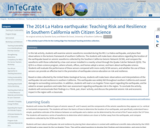
This exercise uses the example of the March 28, 2014 M5.1 La Habra earthquake to teach about earthquake risk and resilience in southern California. Students will examine seismic waveforms recording during the earthquake, as well as read reports from scientific agencies and news outlets to answer basic questions regarding earthquake risk and resilience.
(Note: this resource was added to OER Commons as part of a batch upload of over 2,200 records. If you notice an issue with the quality of the metadata, please let us know by using the 'report' button and we will flag it for consideration.)
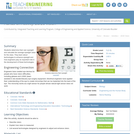
In this activity, students determine their own eyesight and calculate what a good average eyesight value for the class would be. Students learn about technologies to enhance eyesight and how engineers play an important role in the development of these technologies.

SR Caucus Business/Networking Meeting Minutes June 2022

MLA SR Caucus-Mid Year Meeting Minutes October 2022

SR Caucus 2023 April Business Meeting Minutes
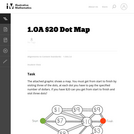
This problem helps students practice adding three numbers whose sum are 20 or less.
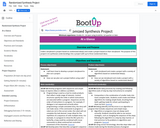
Coders storyboard a project based on randomized idea(s) and create a project based on their storyboard. The purpose of this project is to synthesize understandings into a project with up to three randomized ideas.

As a culminating project for the 4th 9 weeks, students will identify an existing historical timeline and, changing one element, demonstrate how that timeline would play out differently.
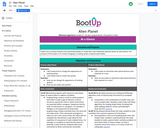
Coders use a variety of blocks and customized sprites to create their own interactive diorama about an alien planet. The purpose of this project is to review changing or creating sprites using the paint editor.
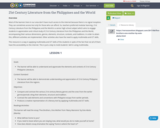
Most of the learners here in our area don't have much access to the internet because there is no signal reception. They can sometimes access but only for those who can afford. So, teachers preferred modular learning. 21st Century Literature from the Philippines and the World is a senior high school subject which aims to engage students in appreciation and critical study of 21st Century Literature from the Philippines and the World, encompassing their various dimensions, genres, elements, structure, contexts, and traditions. In order to attain this, different activities are implemented. Other activities also have the need to apply multimedia and ICT skills. This resource is a way in applying multimedia and ICT skills of the students in spite of the fact that not all of them have the accessibility on the internet. This is just a step to mold students' skill in using multimedia.
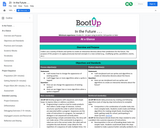
Coders use a variety of blocks and sprites to create an interactive diorama about their predictions for the future. The purpose of this project is to apply previously learned concepts in a new context (e.g., modifying sprites, parallelism, events, etc.).
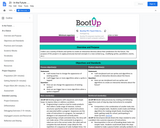
Coders use a variety of blocks and sprites to create an interactive diorama about their predictions for the future. The purpose of this project is to apply previously learned concepts in a new context (e.g., modifying sprites, parallelism, events, etc.).